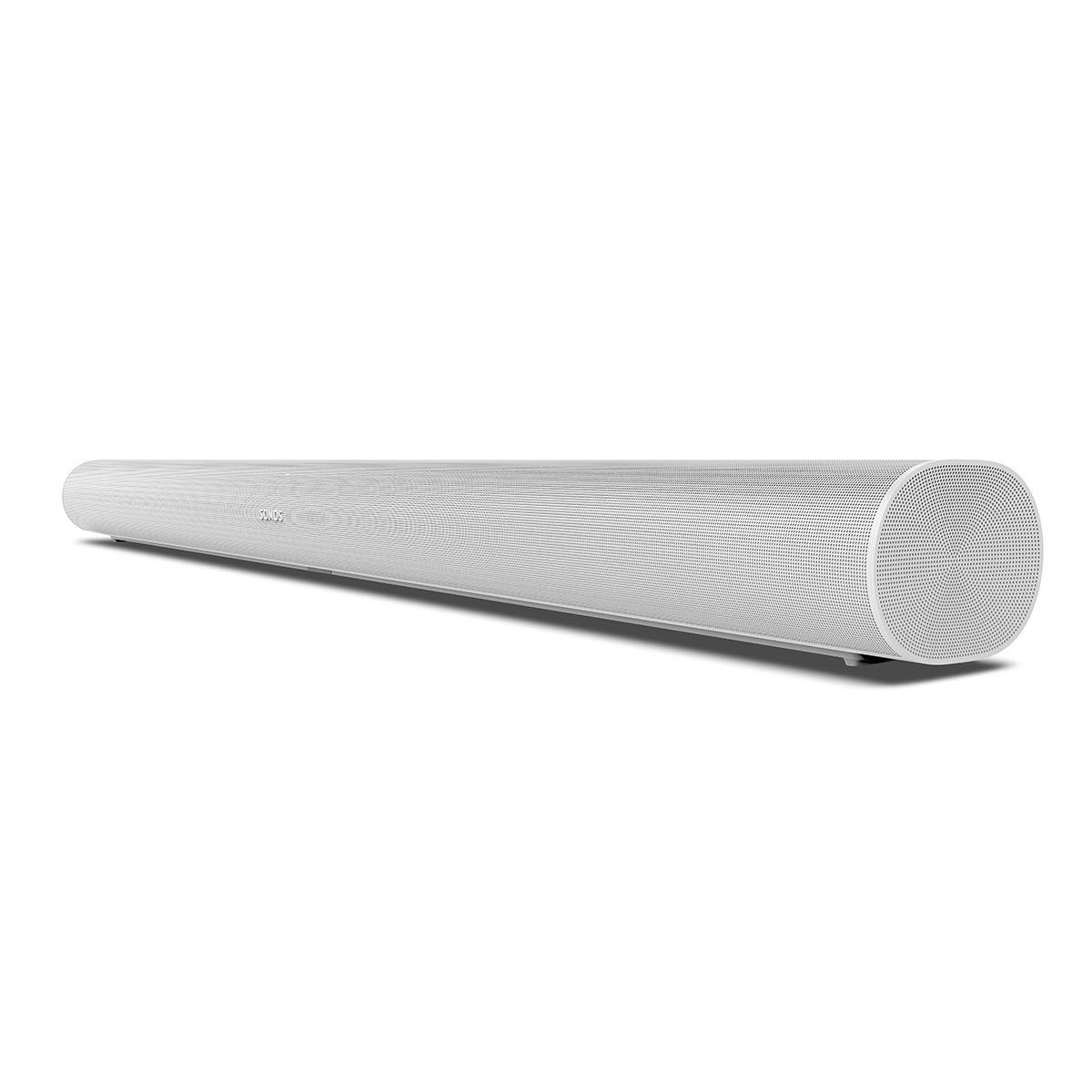
When it comes to upgrading your TV's audio, the choice between the premium Sonos Arc ($564.44) and mid-range Samsung B-Series ($277.99) represents two distinct approaches to better sound. Let's dive into what makes each unique and help you decide which best fits your needs.
Today's soundbars have evolved far beyond simple stereo speakers. They now incorporate sophisticated digital signal processing (DSP), multiple speaker arrays, and smart features that were unimaginable just a few years ago. The key is understanding what capabilities matter most for your specific setup.
The Sonos Arc, released in 2020, showcases what's possible at the premium end. Its 11-driver array includes dedicated upward-firing speakers that bounce sound off your ceiling, creating a dome of sound through Dolby Atmos technology. This creates a truly three-dimensional audio experience - imagine hearing a helicopter actually moving overhead in your favorite action movie.

The Samsung B-Series takes a more traditional approach with its 5.1 channel configuration. While it doesn't offer Atmos support, it provides clear directional audio through its dedicated center channel and side speakers. The included wireless subwoofer handles the low frequencies that give action scenes their impact.
Here's where things get interesting - the Samsung's dedicated subwoofer provides immediate, powerful bass out of the box. The Sonos Arc's integrated woofers deliver tight, controlled bass, but for maximum impact, you'll need to add the optional Sonos Sub (which adds significantly to the cost).
In real-world testing, the Samsung system excels at delivering the kind of room-shaking bass that makes action movies exciting. The Sonos offers more nuanced low-frequency reproduction that some audiophiles might prefer, especially for music.
The Sonos Arc's TruePlay technology (which uses your iPhone's microphone to tune the sound to your specific room) is a game-changer for optimal performance. It compensates for room acoustics in ways the Samsung can't match. However, this feature only works with iOS devices - Android users miss out on this capability.

Released in 2020, the Sonos Arc represents a modern approach to home audio. It functions as a smart speaker with built-in voice assistants (both Alexa and Google Assistant), supports Apple AirPlay 2 for seamless streaming, and integrates with the excellent Sonos multi-room audio system.
The Samsung, while more basic in its smart features, offers practical functionality like Bluetooth multi-connection, letting you easily switch between two connected devices - handy for parties or families sharing music duties.
The Sonos Arc supports virtually every modern audio format, including:

The Samsung B-Series handles standard 5.1 surround sound formats and includes DTS Virtual:X, which attempts to simulate height channels without actual upward-firing speakers.
For pure home theater use, both soundbars excel but in different ways. The Sonos Arc creates a more sophisticated soundstage with better separation and placement of sounds. When watching films mixed in Dolby Atmos, the difference is noticeable - sounds truly appear to come from specific points in three-dimensional space.
The Samsung B-Series delivers impressive performance for its price point. Its dedicated center channel ensures clear dialogue, while the wireless subwoofer adds cinematic impact to explosion-heavy action scenes.

Music playback reveals the biggest differences between these systems. The Sonos Arc's more refined tuning and superior driver array produce more detailed, accurate music reproduction. The Samsung system, while competent, focuses more on impact than subtlety.
The Sonos ecosystem allows for future expansion - you can add rear speakers, a subwoofer, or additional Sonos speakers throughout your home. While expensive, this flexibility adds long-term value.
The Samsung system provides everything needed for a complete surround sound experience at a lower initial cost. While it can't be expanded as extensively as the Sonos, it delivers impressive performance for its price point.
Since its 2020 release, the Sonos Arc has received regular software updates adding features and improving performance. Sonos has a strong track record of supporting products for many years, suggesting the Arc will remain current for the foreseeable future.
The ideal choice ultimately depends on your specific needs and budget. The Sonos Arc represents the premium end of soundbar technology, while the Samsung B-Series offers impressive performance at a more accessible price point.
For most users, the Samsung provides excellent value and satisfying performance. However, if you're an audiophile or technology enthusiast who will appreciate the advanced features and superior sound quality, the Sonos Arc's premium price is justified by its exceptional performance and future-proof design.
| Sonos Arc ($564.44) | Samsung B-Series ($277.99) |
|---|---|
| Audio Configuration - Determines sound quality and immersion | |
| 5.0.2 channels with 11 drivers including upward-firing Atmos | 5.1 channels with dedicated subwoofer |
| Speaker Array - Impacts clarity and sound separation | |
| 8 woofers, 3 tweeters, precisely angled drivers | 6 speakers total including center channel and side-firing |
| Bass Capability - Affects movie impact and music depth | |
| Integrated bass, optional subwoofer available ($749 extra) | Included wireless subwoofer with Bass Boost mode |
| Advanced Audio Formats - Important for home theater | |
| Dolby Atmos, TrueHD, Digital Plus, Multichannel PCM | Dolby Digital 5.1, DTS Virtual:X |
| Smart Features - Enables voice control and streaming | |
| Alexa/Google built-in, AirPlay 2, Sonos app control | Basic Bluetooth with multi-device connection |
| Room Correction - Optimizes sound for your space | |
| TruePlay automatic tuning (iOS only) | Basic EQ adjustments |
| Connectivity Options - Affects setup flexibility | |
| HDMI eARC, optical, ethernet, WiFi | HDMI ARC, optical, Bluetooth |
| Expandability - Future upgrade potential | |
| Full Sonos ecosystem compatibility, wireless surrounds | No additional speaker expansion options |
| Physical Design - Consider space and aesthetics | |
| 45" wide, 3.4" tall, 13.78 lbs, premium finish | 40.5" wide, 2.3" tall, plus separate subwoofer |
| Power Output - Impacts maximum volume | |
| Not specified, but fills large rooms effectively | 70W total (25W soundbar, 45W subwoofer) |
| Special Features - Unique capabilities | |
| Night mode, Speech enhancement, TruePlay, Multi-room audio | Game Mode, Night mode, Voice enhancement |
| Setup Complexity - Consider technical comfort | |
| More complex initial setup, app required | Simple plug-and-play connection |
| Warranty and Support - Long-term value | |
| 1-year warranty, excellent software update history | 1-year warranty, basic support |
The Sonos Arc ($564.44) offers superior movie performance with Dolby Atmos and better sound separation. However, the Samsung B-Series ($277.99) provides good movie performance at a lower price point with included subwoofer for deeper bass.
The Sonos Arc costs $564.44, while the Samsung B-Series is priced at $277.99, making it a more budget-friendly option at less than half the price.
Out of the box, the Samsung B-Series has better bass thanks to its included wireless subwoofer. The Sonos Arc requires purchasing a separate subwoofer for comparable bass performance.
The Samsung B-Series offers simpler plug-and-play setup, while the Sonos Arc requires app configuration but provides more customization options.
Both support music streaming, but the Sonos Arc offers superior options with AirPlay 2, built-in voice assistants, and the Sonos app. The Samsung B-Series primarily relies on Bluetooth connectivity.
The Samsung B-Series is well-suited for small to medium rooms, while the Sonos Arc is designed for medium to large spaces but can adapt using TruePlay tuning.
The Samsung B-Series includes a wireless subwoofer. The Sonos Arc works without one but offers optional subwoofer integration for enhanced bass.
The Sonos Arc offers significantly more smart features, including voice assistants and multi-room audio. The Samsung B-Series provides basic Bluetooth connectivity.
Yes, both soundbars connect via HDMI ARC, with the Sonos Arc supporting the newer eARC standard for higher-quality audio formats.
The Sonos Arc creates more immersive surround sound with Dolby Atmos support, while the Samsung B-Series offers traditional 5.1 channel surround sound.
Both are well-built, but the Sonos Arc has a better track record of software updates and long-term support compared to the Samsung B-Series.
The Samsung B-Series offers better immediate value with included subwoofer and good performance. The Sonos Arc justifies its higher price with superior sound quality and advanced features.
We've done our best to create useful and informative comparisons to help you decide what product to buy. Our research uses advanced automated methods to create this comparison and perfection is not possible - please contact us for corrections or questions. These are the sites we've researched in the creation of this article: whathifi.com - soundandvision.com - en.community.sonos.com - cnet.com - worldwidestereo.com - abt.com - creativeaudio.net - target.com - sonos.com - worldwidestereo.com - businessinsider.com - en.community.sonos.com - youtube.com - bestbuy.com - abt.com - avsforum.com - crutchfield.com - camelcamelcamel.com - samsung.com - samsung.com - samsung.com - images.samsung.com - samsung.com - avblinq.avbportal.com - samsung.com - samsung.com